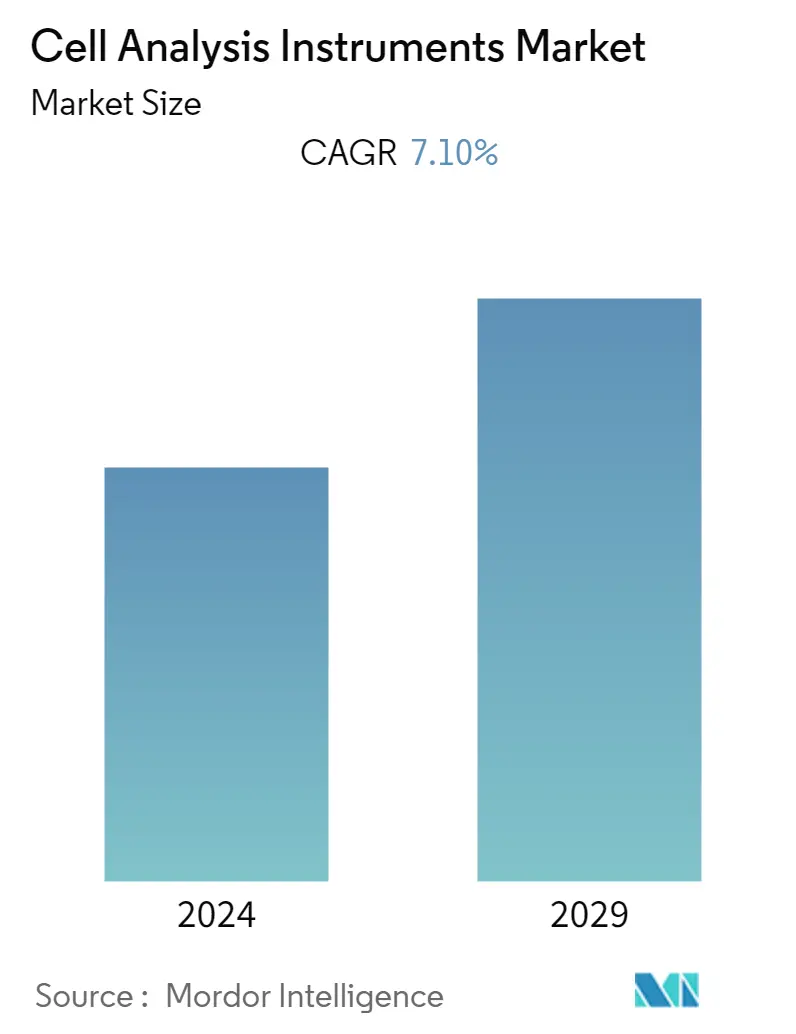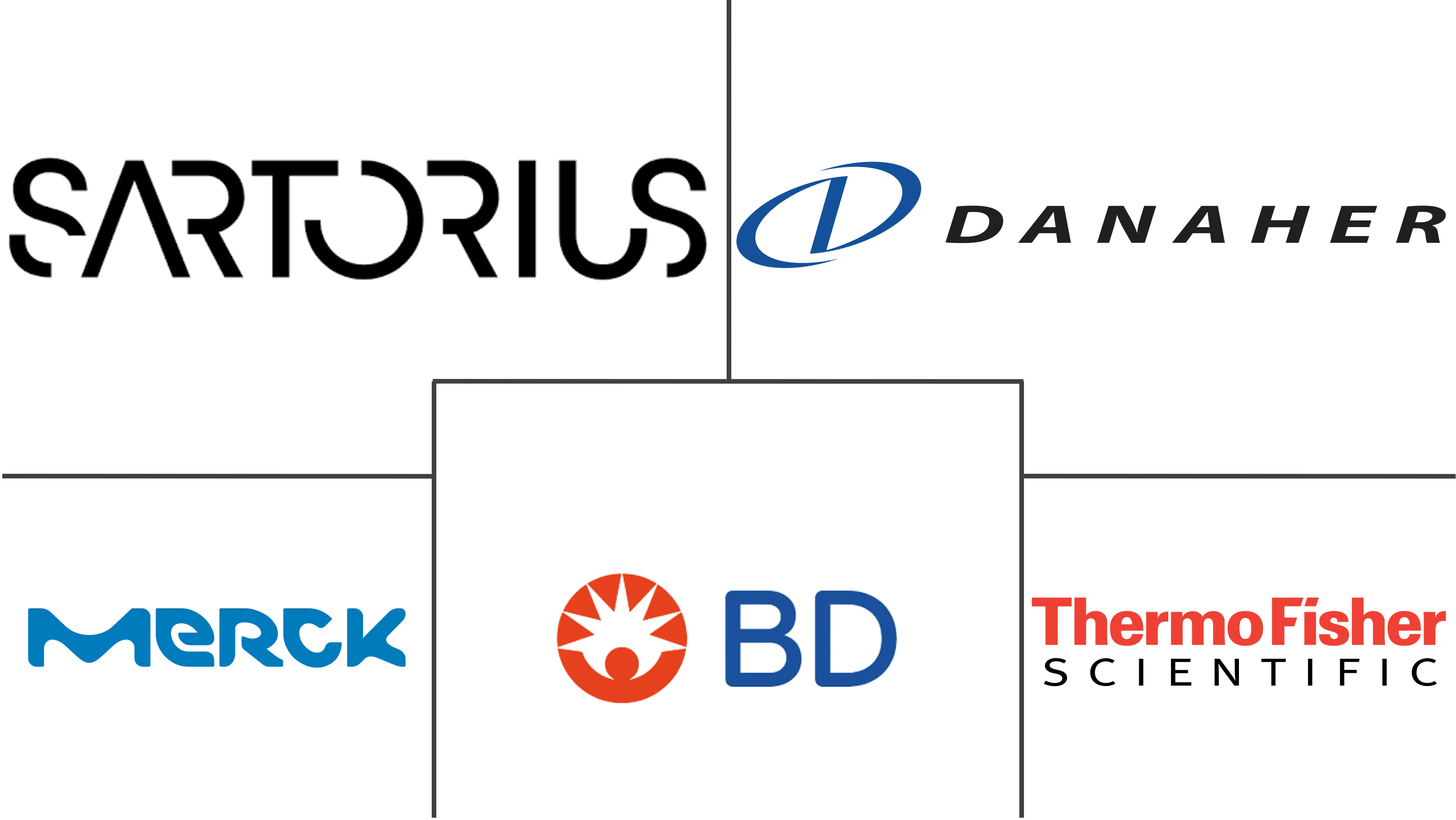Market Size of Cell Analysis Instruments Industry

| Study Period | 2019 - 2029 |
| Base Year For Estimation | 2023 |
| Forecast Data Period | 2024 - 2029 |
| CAGR | 7.10 % |
| Fastest Growing Market | Asia Pacific |
| Largest Market | North America |
Major Players
*Disclaimer: Major Players sorted in no particular order |
Cell Analysis Instruments Market Analysis
The cell analysis instruments market is expected to register a CAGR of 7.1% over the forecast period.
COVID-19 had a significant impact on the cell analysis instruments market since cell count and viability tests were widely carried out during the pandemic. According to an article published in February 2022 in News Medical life sciences, the number of WBC cell counts is a crucial indicator of inflammation; higher than 11,000 WBCs per unit microliter of blood counts may affect COVID-19 patients' hospital discharge and mortality rates. Similarly, as per an article published in June 2021 in the BMC journal, a higher WBC count ( 6.16 10^9/L) should be given more attention in the treatment of COVID-19. Developments such as these put cell analysis at the forefront during the pandemic and have contributed greatly to the growth of the market, which is expected to continue its positive, upward trend in the coming years.
Another factor that has played into the growth of the market is the growing burden of cancer across the globe and the expanding biotech industry and research in cell biology. For instance, per an American Cancer Society 2022 update, 1,918,030 new cancer cases were estimated in the United States in 2022. Furthermore, cell analysis in cancer is widely used by researchers to identify various criteria. An article published in November 2022 in the Nature journal mentioned that researchers performed a pan-cancer analysis on 226 samples across 10 solid cancer types to profile the tumor microenvironment (TME) at single-cell resolution, illustrating the commonalities/plasticity of heterogenous CAFs (cancer-associated fibroblasts).
Furthermore, product launches, strategic collaborations, and acquisitions by key players are expected to drive market growth over the forecast period. For instance, in August 2022, DeNovix Inc, the manufacturer of the award-winning CellDrop Automated Cell Counter, developed two dedicated nuclei counting apps capable of differentiating isolated nuclei and intact cells from debris. The CellDrop Series is a line of image-based, automated cell counters. Systems include a high-definition 7-inch touchscreen for live preview and instant review of results.
While several developments predict growth, the high cost of cell analysis and complex regulatory scenarios are anticipated to restrain the market growth over the forecast period.
Cell Analysis Instruments Industry Segmentation
As per the scope of the report, cell analysis deals with the study of cells, which are isolated from tissues in multicellular organisms and unicellular organisms. Cellular analysis plays a vital role in gene identification, protein identification, epigenomics, and other life science-related areas. It is a natural process to study the genetic and phenotypical characteristics of an organism. Cell analysis instruments include consumables such as reagents, assays, kits, and instruments that are required during cell analysis.
The cell analysis instruments market is segmented by Product (Instruments and Consumables), Application (Cell Counting, Cell Viability, Cell Identification, Target Identification, PCR, Others), End-User (Academic and Research Institutes, Pharmaceutical & Biotechnology Companies, Others), and Geography (North America, Europe, Asia-Pacific, Middle East, and Africa, South America). The market report also covers the estimated market sizes and trends for 17 different countries across major regions globally. The report offers the value (in USD million) for the above-mentioned segments.
| By Product | |||||||
| |||||||
| Consumables |
| By Application | |
| Cell Counting | |
| Cell Viability | |
| Cell Identification | |
| Target Identification | |
| PCR | |
| Other Applications |
| By End-User | |
| Academic and Research Institutes | |
| Pharmaceutical & Biotechnology Companies | |
| Other End-Users |
| Geography | ||||||||
| ||||||||
| ||||||||
| ||||||||
| ||||||||
|
Cell Analysis Instruments Market Size Summary
The cell analysis instruments market is poised for significant growth, driven by the increasing demand for advanced diagnostic and research tools in various fields, including oncology and biotechnology. The market's expansion is largely attributed to the heightened focus on cell counting and viability tests, which gained prominence during the COVID-19 pandemic. This surge in demand has been further bolstered by the rising incidence of cancer globally, prompting extensive research and development in cell biology. The market is characterized by the introduction of innovative products and technologies, such as automated cell counters and advanced hematology analyzers, which are enhancing the accuracy and efficiency of cell analysis. Strategic collaborations and acquisitions among key industry players are also contributing to the market's robust growth trajectory.
North America is expected to maintain a substantial share of the market, supported by increased funding for cell-based research and a high prevalence of cancer. The region's market growth is further fueled by the presence of major companies and their continuous efforts in research and development. The competitive landscape of the cell analysis instruments market is moderately fragmented, with both local and global players vying for market share. While international companies like Thermo Fisher Scientific and Sartorius AG dominate the market, there is a notable presence of local players in developing countries. The market's future growth is anticipated to be driven by technological advancements and the emergence of new players, as well as ongoing innovations in cell analysis technologies.
Cell Analysis Instruments Market Size - Table of Contents
-
1. MARKET DYNAMICS
-
1.1 Market Overview
-
1.2 Market Drivers
-
1.2.1 Increase in Burden of Chronic Diseases
-
1.2.2 Growing Biotech Industry and Research in Cell Biology
-
-
1.3 Market Restraints
-
1.3.1 High Cost of Cell Analysis
-
1.3.2 Complex Regulatory Scenario
-
-
1.4 Porter's Five Forces Analysis
-
1.4.1 Threat of New Entrants
-
1.4.2 Bargaining Power of Buyers/Consumers
-
1.4.3 Bargaining Power of Suppliers
-
1.4.4 Threat of Substitute Products
-
1.4.5 Intensity of Competitive Rivalry
-
-
-
2. MARKET SEGMENTATION (Market Size by Value - USD Million)
-
2.1 By Product
-
2.1.1 Instruments
-
2.1.1.1 Microscopes
-
2.1.1.2 Flow Cytometers
-
2.1.1.3 Spectrophotometers
-
2.1.1.4 Cell Microarrays
-
2.1.1.5 Other Products
-
-
2.1.2 Consumables
-
-
2.2 By Application
-
2.2.1 Cell Counting
-
2.2.2 Cell Viability
-
2.2.3 Cell Identification
-
2.2.4 Target Identification
-
2.2.5 PCR
-
2.2.6 Other Applications
-
-
2.3 By End-User
-
2.3.1 Academic and Research Institutes
-
2.3.2 Pharmaceutical & Biotechnology Companies
-
2.3.3 Other End-Users
-
-
2.4 Geography
-
2.4.1 North America
-
2.4.1.1 United States
-
2.4.1.2 Canada
-
2.4.1.3 Mexico
-
-
2.4.2 Europe
-
2.4.2.1 Germany
-
2.4.2.2 United Kingdom
-
2.4.2.3 France
-
2.4.2.4 Italy
-
2.4.2.5 Spain
-
2.4.2.6 Rest of Europe
-
-
2.4.3 Asia-Pacific
-
2.4.3.1 China
-
2.4.3.2 Japan
-
2.4.3.3 India
-
2.4.3.4 Australia
-
2.4.3.5 South Korea
-
2.4.3.6 Rest of Asia-Pacific
-
-
2.4.4 Middle East and Africa
-
2.4.4.1 GCC
-
2.4.4.2 South Africa
-
2.4.4.3 Rest of Middle East and Africa
-
-
2.4.5 South America
-
2.4.5.1 Brazil
-
2.4.5.2 Argentina
-
2.4.5.3 Rest of South America
-
-
-
Cell Analysis Instruments Market Size FAQs
What is the current Cell Analysis Instruments Market size?
The Cell Analysis Instruments Market is projected to register a CAGR of 7.10% during the forecast period (2024-2029)
Who are the key players in Cell Analysis Instruments Market?
Becton Dickinson and Company, Sartorius AG, Danaher Corporation, Merck KGaA and Thermo Fisher Scientific are the major companies operating in the Cell Analysis Instruments Market.

